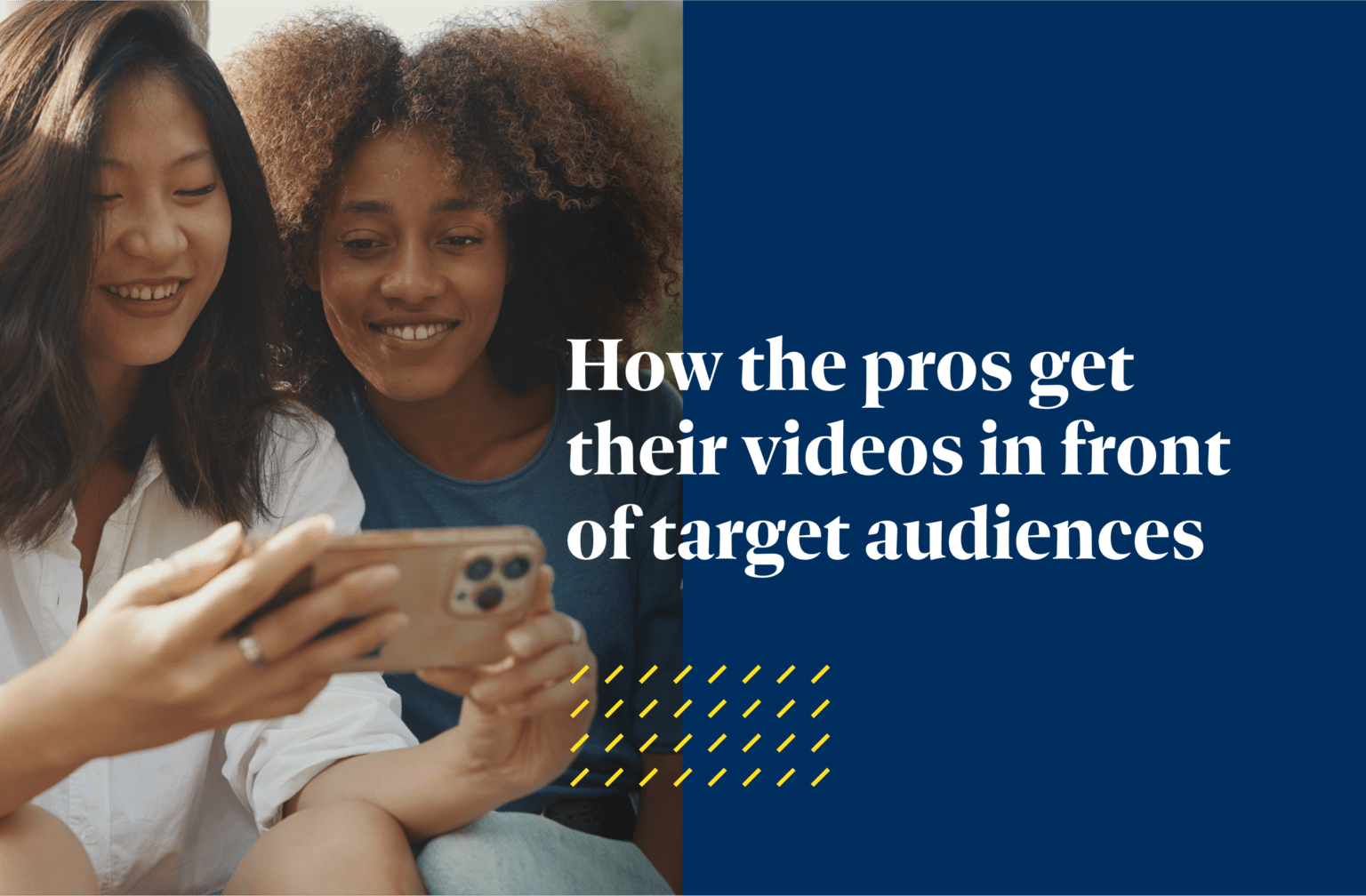No matter how great your videos are, you don’t grow an audience by hitting “post” and hoping for the best. Even if you get lucky and go viral once, there’s no guarantee it’ll happen again. If you want to consistently connect with your target audiences, you’ve got to know what makes them tick. The most successful marketing and video production teams use several techniques to get inside the heads of their target audience. Those methods help them understand who their audience is, what they’re interested in, and where they spend their time online.
But before you think about how to reach your target audience, you need to understand who exactly you’re targeting and why. In our new video strategy guide, “How to create a contemporary video strategy”, you’ll hear from top marketers and video producers how identifying and understanding their target audience has helped them magnify their messaging’s reach.
Expert advice on finding your target audience
For the guide, we had extensive conversations with marketing and video production leaders from Storyblocks’ enterprise partners HubSpot and Descript, as well as our in-house experts. Throughout these interviews, they provided so many valuable insights that we couldn’t fit into the guide. This accompanying series of blogs each take a deeper dive into the learnings that these leaders shared with us.
The professionals who shared some of their expertise for our guide are:
- Kyle Denhoff, Director of Marketing, HubSpot
- Lara Unnerstall, Video Producer, Descript
- Ryan Vig, Marketing Leader, Descript
- Lauren Zoltick, Director of Performance Marketing, Storyblocks
- Kaitlyn Rossi, Senior Producer, Storyblocks
Want to learn more about how marketers are retooling their video strategies in a shaky economy? Download Storyblocks’ How to create a contemporary video strategy guide.
Defining your target audience
Before you start filming, take a step back to consider who you’d like your videos to reach. Singling out your most important audience helps you understand what they want to see. Understanding who your target audience is gives your videos a much better chance of serving their intended purpose.
As Ryan Vig, Marketing Leader at Descript explains, “It’s really understanding who your ideal customer is, what characteristics make them most valuable to your company, and understanding what their motivation and pain points are. Once you understand their problems and challenges, you can really move on to how to talk to them. I think one of the most important things to do that is user research.” User research can include surveys, interviews, focus groups, and more.
After getting to know your target audience, you’ll be better prepared to speak to them in a language they’ll understand. Now you can create videos that address issues specific to your audience and set goals accordingly.
Kyle Denhoff, the Director of Marketing at Hubspot, gives the example that the goals of a video targeting social media community managers would be very different than tech company vice presidents. “They’re not interested in the same things, they look at their work very differently, they actually don’t solve the same problems. And so the video is going to have to be tailored to them.”
Don’t try to speak to every target audience
Some companies sell the same product or service across multiple audiences, all with different priorities. This can present a challenge in ensuring your videos are relatable to everyone you’re trying to reach. But if you try to appeal to everyone, you’re less likely to find success across the board. So what resonates for one group could fall flat for another.
To avoid your video flopping, Kyle suggests truly defining your audience and asking, “Who are we writing for? Who are we creating this video for?” Once you know that, then you can proceed to the next step – understanding where your audience is online.
Supplemental content alert: In case you missed it, we talk further about getting to know your audience and how to reach them in episode 2 of our Beginner’s guide to creating video series.
Know where your target audience lives online
There are a lot of platforms out there serving up different types of content for different audiences. Accurately targeting the viewers you want to reach is difficult if you don’t know where they’re spending their time online. So it’s also important to know what’s expected from different platforms to avoid a misalignment with your video’s business objectives.
Creating videos for social media can seem daunting, but it’s all about understanding the value of each platform. YouTube is the second biggest search engine on the internet, Lara Unnerstall, Video Producer at Descript, gives as an example. People go there to learn how to do things. In comparison, people aren’t searching as frequently searching on TikTok for educational content.
“It’s such a wide open playing field with video strategy – you really just have to know what the business goals are, or what would best serve the audience you’re trying to reach. Then find the distribution channels that are appropriate for it and make content that is optimized for those channels,”
— Lara Unnerstall, Video Producer, Descript
Video marketers and production teams use different tools to enhance their understanding of their target audiences. This includes taking a dive into their metrics, which most social media platforms provide. From there, marketers can gain all kinds of insights about the customer journey, including the size of their potential audience on various platforms and what they can expect from each of them.
Other factors to consider with your target audience
Before you shoot a single frame, Lauren Zoltick, Director of Performance Marketing at Storyblocks, says it’s important to consider a few key factors. Those include the type of content you’re producing, what you’re trying to sell, and even your audience’s next destination online after they’ve viewed your video.
“I always think it starts with thinking about where your audience is, not just from the social channels that they use, but from where they are in terms of the buyer journey, and how you can kind of meet them where they are and guide them along, ” Lauren suggests.
Those factors are important to include in the goals you set and how you measure the success of your videos. If your video’s goal is spreading awareness for your product, you might set a goal of improving traffic to your website. But if your video is targeted at people who have already been to your website before, your goal might be to hit a specific number of transactions.
Refining your messaging for your target audience
Once you’ve established who your audience is and where you can find them, you’re ready to start dialing in your messaging. Effective messaging is clear and concise. It gets your point across quickly, ideally in a single sentence or two.
As Kaitlyn Rossi, Senior Producer at Storyblocks, points out, “Video does an incredibly good job of really engaging different emotions and senses with people. And if you’re doing it well, it is the best way to distill a lot of information down into a very short period of time when you’re trying to capture and hold attention.”
Getting your target audience to stop and watch your video when there’s a million others competing for their attention is hard. But it’s not impossible. Grabbing their attention right away is an important factor for engaging your audience.
Ryan also notes that the way your audience behaves tells you a lot about how they like to consume information. “It also gives you an opportunity as a brand to be able to communicate in a very effective way. Whether that’s through storytelling, or demos or tutorials, or something that’s more engaging person to person.”
That’s where user research can come in handy yet again. If you can find out where your audience lives online, you can also find out what channels or creators they like to watch. Then you can look at those channels as a source of inspiration for your own videos.
Setting yourself apart from the competition
Chances are no matter what kind of videos you create, someone else is out there trying to cater to the same audience. To set yourself apart, you need to determine what topics or angles your competitors might have missed. So then you can fill in those gaps with your own videos.
But as Kaitlyn points out, “Figuring out what content works well with them, and what feels on brand for you, then making that over and over and over again, is a really tough cycle. And I think that whole cycle is the biggest challenge for producers and for marketers today.”
Hosting creative brainstorms with your entire team can help spark new ideas and keep videos fresh. And including people from other departments can help provide different perspective, too!
Want even more expert tips for creating your video strategy?
Video marketers and production teams across every industry are working to capture the attention of their target audiences. Even if your audiences overlap, a clear and detailed strategy can put you out ahead of the competition. To learn more from the experts we interviewed and improve your video strategy, download How to create a contemporary video strategy for free today.




